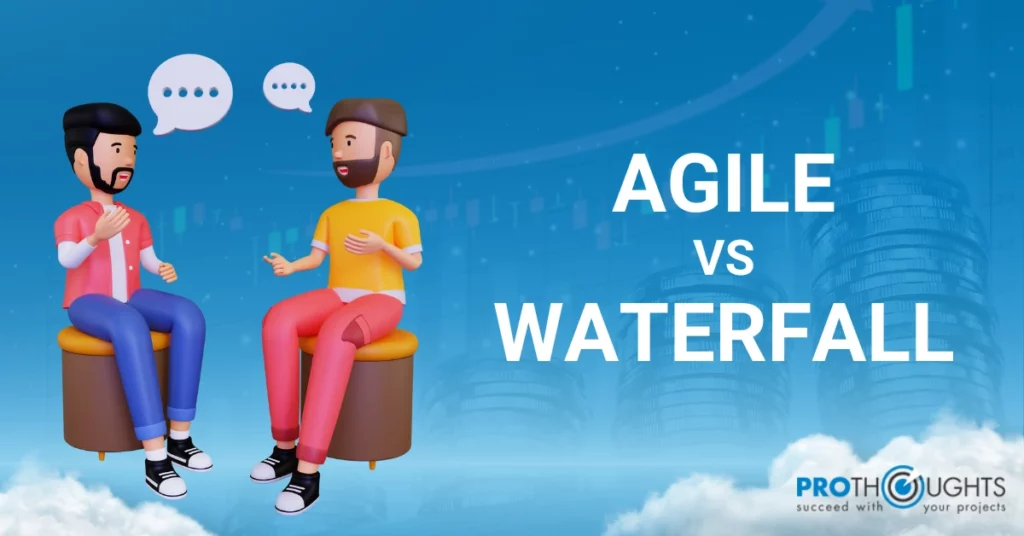
Agile and Waterfall: What are they?
The PMP certification throws light on the two different as well as the two well-known approaches to project management, Agile, Waterfall as well as hybrid project management. Although the software development industry widely uses both, each category of work is better excelled at by one over the other.
The primary distinction lies in that, Waterfall is a method of working that follows a linear process and mandates that the team finish each project phase before going on to the next one. In contrast, Agile encourages the team to work simultaneously on several project phases.
In this guide, we will look at a comprehensive comparison of these top methodologies, complete with factors you must consider when deciding between Agile and Waterfall for your project. Let’s dive in!
Agile and Waterfall Methodology
-
Agile Methodology
Approach: Frequent interaction with stakeholders.
Flexibility: High
Agile methodology demands both the initiative of the team and strict adherence to the timetable. The Agile approach was established in reaction to the more stringent structure of the Waterfall methodology. Due to this, it’s a style of project management that’s much more adaptable. It is possible to spend years working on a single software development project, during which substantial technological advancements may have occurred. Agile was designed to be a flexible methodology open to adopting direction changes even at a later stage. Additionally, Agile considers stakeholders’ feedback at every stage of the process.
In Agile, the team works on project phases concurrently, and the deadlines for these phases are frequently very short-term. In addition, the team, rather than a project manager, determines the path the project will take. However, for the team to be more motivated and productive, there is a need for them to become more self-directed.
2. Waterfall Methodology
Approach: Hands-off strategy with predetermined objectives and results.
Flexibility: Low
Waterfall methodology is an approach to project management that emphasizes following a linear path from the start of a project to its conclusion. This approach, which is frequently utilized by engineers, is front-loaded and places reliance on sequential execution, meticulous planning, and extensive documentation.
The Waterfall methodology, a linear approach to project management, is suitable for projects where the team knows the result at the outset. The project’s clear expectations and the spelled-out deliverables of each stage determine what is needed to advance to the next step.
Pros of Agile Methodology
The 7 pros of Agile Methodology are listed below
1. Increased flexibility and adaptability:
Agile allows for changes and adjustments to be made throughout the development process, which can help teams respond to evolving requirements and market conditions.
2. Faster time to market:
Agile promotes shorter development cycles, allowing for quicker delivery of working software and faster time to market.
3. Improved customer satisfaction:
By involving customers in the development process and delivering working software incrementally, Agile ensures that customer needs and expectations are met more effectively.
4. Enhanced collaboration and communication:
Agile encourages close collaboration between team members, stakeholders, and customers, fostering better communication and alignment throughout the project.
5. Continuous improvement:
Agile emphasizes regular feedback and reflection, enabling teams to improve their processes and deliver higher-quality software continuously.
6. Reduced risk:
Agile’s iterative approach helps identify and address potential issues early on, reducing the risk of project failure or costly rework.
7. Increased transparency:
Agile promotes transparency by making project progress and priorities visible to all stakeholders, fostering trust and accountability.
Pros of Waterfall methodology
1. Clear and well-defined project requirements:
The Waterfall methodology emphasizes thorough planning and documentation to ensure that project requirements are clearly defined.
2. Sequential and structured approach:
The Waterfall methodology follows a linear and sequential process, where each phase is completed before moving on to the next. This provides a clear roadmap for the project and helps manage dependencies effectively.
3. Easy to understand and manage:
The Waterfall methodology is relatively easy to understand and manage, especially for projects with well-defined requirements and a stable scope.
4. Documentation-driven:
Waterfall places a strong emphasis on documentation, which helps in maintaining a record of project progress, requirements, and decisions made throughout the project lifecycle.
5. Well-suited for projects with fixed scope and requirements:
Waterfall is particularly effective for projects with fixed sizes and requirements, where changes are less likely to occur once the project has started.
6. Clear milestones and deliverables:
The Waterfall methodology enables us to establish clear milestones and deliverables at each phase, making it easier to track progress and measure success.
7. Well-established and widely used:
Supporters can access many resources, tools, and best practices to implement the well-established and widely used waterfall project management methodology.
Agile and Waterfall: The differences
| Waterfall | Agile | |
|---|---|---|
| Timeline | There is a set schedule for the Waterfall. The concept is that the project's inception and end have already been planned. | Agile is far more adaptable and allows for trying out various strategies. Instead of a set deadline, the schedule changes as the project progresses. |
| Client Engagement | Waterfall does not involve the project owner or the client at any point in the process, except for particular check-ins or deliverables once the goal has been established. The process only continuously considers client feedback because the project's course is planned from the beginning. | Agile strongly focuses on the value of including clients in all phases of project development. Agile Manifesto states, "Our highest priority is to satisfy the customer through early and continuous delivery of valuable software." Therefore, business owners are expected to be involved and offer feedback to the software development team as the project progresses through its numerous phases. |
| Flexibility | Waterfall requires completing each stage before moving on to the next, making it less flexible than Agile. This management method is ideal for teams with a clear destination in mind and can plot out their entire journey in advance. | The Agile framework was created with adaptability in mind. Sprints are brief intervals of time used to perform work. Even when new insights are introduced later in the development process, the technique is adaptable enough to take them into account. |
| Budget | Fixed. The budget is typically set in stone when a project is designed using the Waterfall method. If the project's scope is predetermined, there will be less room for readjusting the budget midway through the project. | Flexible. Agile allows for experimentation and course corrections even in the twilight of a project's development. This gives us more wiggle room in the spending plan. |
Projects with a clear objective best utilize the waterfall because it follows a linear project progression. If a project owner has a clear and detailed vision of an app, for example, and believes that it will not change throughout the project’s development, then they could make a smart choice by following a system like the Waterfall approach.
Agile, on the other hand, provides a great deal of leeway for modifications and shifts in strategy as the project progresses. It performs well for tasks where additional research or testing could potentially affect the results.
Projects that follow Waterfall techniques typically have a less flexible budget because they plan out the project from the very beginning. As there is more leeway to change the course of the project as it progresses while using Agile, the budget is also subject to change. Similarly, the beginning of a Waterfall project determines its timeframe, while the development of an Agile project shapes its timeline.
What to Consider When Deciding Between Agile and Waterfall for Your Project?
When choosing between the Agile and Waterfall methodologies, you should consider several factors.
Some questions to ponder are as follows.
Does your project have strong guidelines or limitations? Waterfall projects are ideal for those that must adhere to specific guidelines or standards. Thus, the deliverables and procedures established at the beginning of each phase guarantee that these standards will be met. The Department of Defence and the aerospace industry are two examples of organizations more likely to use Waterfall than Agile due to the inherent safety risks associated with Agile’s iterative development approach.
When picking between Agile and Waterfall, it’s essential to consider the level of participation of the project’s owners or stakeholders. Agile works best when there is constant communication and collaboration between all parties involved in the project. The Waterfall is a highly structured approach to project management that restricts creativity.
Conclusion
In conclusion, the methodologies known as Agile and Waterfall are two unique approaches to managing projects. Waterfall may be the best approach if you know exactly what you want out of the project from the get-go. People favor the Waterfall method when they need to meet strict requirements because it requires completing one stage before moving on to the next.
Instead, teams who value speed, experimentation, and jumping in without knowing every detail of the final product might consider adopting the Agile methodology. A flexible and collaborative and self-motivated workforce is necessary for Agile, and stakeholders and business owners need to provide frequent updates on the progress being made.




